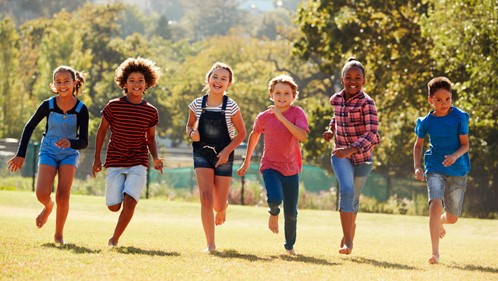Motion is lotion. Motion and movement is what keeps us alive, allowing our body to perform necessary functions such as our heart beating and pumping blood around the body to bring oxygen and nutrition to every cell. Our heart beating is only one of the many primitive ways in which we are designed to move. Primitively for survival we are designed to hunt for food and run away from danger. We were not designed to predominantly walk from the car, to the fridge, couch, desk and back.
According to Nobel Prize recipient Dr. Roger Sperry’s research, 90% of the stimulation and nutrition to the brain is generated by the movement of the spine. Dr Sperry believes when the spine is moving, it is like a windmill creating electricity1.

Motion is Lotion
Benefits of Exercise and Movement
Exercise and movement includes playing soccer or tennis, lifting weights and running on a treadmill. However, it does not need to be so complicated. For children, free play alone is very beneficial. It develops social, emotional and academic foundations for later in life. It also improves emotional intelligence, the ability to self-heal, learn about themselves, what they’re good at or not so good at, what they like or don’t like to do.2 Many health experts believe free play has been interrupted by the increasing amount of artificial intelligence and robots when it should really be kept simple. There are so many skills and traits only we can develop through free play and not technology such as compassion, creativity, complexity and dexterity.
Through movement and exercise we also build postural strength which takes consistent firing of the postural muscles which leads to brain stimulation. And as the muscles continue to build strength, the neural pathways in the brain also thrive. This feedback system is what makes our posture strong and consistent and is how we can have good posture without having to think about it.
Research has found many benefits of good posture and exercise, even in children with ADHD and autism. Some of the main findings are decreased stress, anxiety and depression as well as improved mood, behaviour, motor performance, social skills and even academic performance.3,4
What do the Australian guidelines recommend?
- For babies, parents should provide plenty of tummy time and limit restrained time in capsules, car sets and strollers
- Children under 5 should enjoy at least 3 hours of physical activity per day
- Children over 5 and adults should do at least 1 hour of moderate to vigorous exercise per day5
You may be questioning: “Where can I find that time?” Just remember, exercise is simply movement which increases the heart rate so it does not have to be a planned activity, but rather could be taking the stairs instead of the lift for example.
If you have any questions or would like to have yourself or your child’s spine and posture checked by Dr Cindy Lam, please contact Provolution Health on 6299 2660.
CONTACT US TODAY

Dr. Cindy Lam
After suffering with low back pain related to her menstrual cycle as a teen, and finding incredible results and relief with Chiropractic care, Cindy knew by the age of 14 that she wanted to pursue Chiropractic to bring that same opportunity to you. Having studied at Macquarie University, she has graduated with a Bachelor of Chiropractic Science and a Master of Chiropractic.
Dr. Cindy is grateful to be surrounded by a wonderful and exceptional team, and to be working in her chosen profession. She loves seeing the changes in people’s health and quality of life because of their body’s innate ability to heal.
References:
- Plasker E. Achieving Optimum Brain-Body Alignment.
- Trudeau, F. and Shepard, R. Physical education, school activity, school sport and academic performance. Int J Behav Nutr Phys Act. (2008) (5)
- Kamp, C.F., et al. Exercise reduces the symptoms of Attention-Deficit/Hyperactivity Disorder and improves social behaviour, motor skills, strength and neurophysiological parameters. Acta Paediatrica, Volume 103, (2014) July
- Sowa, M. Effects of physical exercise on autism spectrum disorders: a meta-analysis. Research in Autism Spectrum Disorders, Volume 6, (2012)
- https://www.health.gov.au/health-topics/physical-activity-and-exercise/physical-activity-and-exercise-guidelines-for-all-australians
